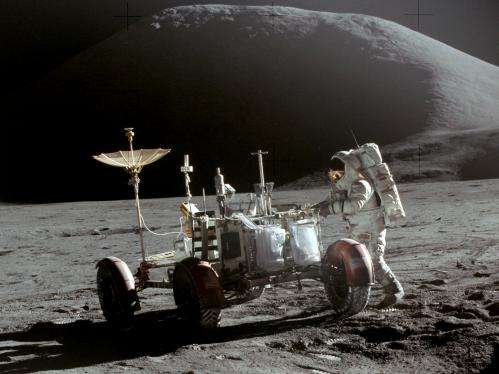Lunar rovers could be engulfed by dust

(Phys.org) —Space agencies around the world have plans to continue the exploration of the Moon in the next two decades, with ever more sophisticated robots paving the way for astronauts to walk on the lunar surface once again. One major issue for these projects is the dust found on the lunar surface, material that is abrasive, sticky and unhealthy to breathe. Now an Anglo-French team of scientists have modelled how this dust will affect any rover vehicles travelling across the surface. They find a serious risk that rovers that move around sunrise and sunset could be engulfed in dust. Professor Farideh Honary of the University of Lancaster will present the new work at the RAS National Astronomy Meeting in St Andrews on Wednesday 3 July.
In the 1960s and 1970s the United States and Soviet Union sent a series of robotic (Surveyor and Luna) and crewed missions (Apollo) to land on the Moon. These give contemporary scientists a bank of data on the lunar environment including dust. The major issues associated with it are abrasiveness, adherence to clothing and equipment, visibility reduction particularly during landing and the effect on human health of breathing in the dust particles. Astronauts found that the dust stuck to all materials, something that could be fatal if it compromised life support systems.
Farideh will present a study of the simulated motion of lunar dust near a rover, part of a joint project with ONERA in France to study dusty environments where electrical charging has a strong effect.
Simulations were made for two different lunar regions, the boundary between night and day (terminator) where the sun would either be rising or setting and the region experiencing full daylight. The rover vehicle was modelled as a 3m x 1.5m x 2m rectangular box located in the middle of the simulation domain and placed 1 metre above the lunar surface.
The scientists simulated an area of on the Moon, 30 m long x 30 m wide and 20 m high. Dust particles were introduced into the simulation over a period of time, when both the surface and the rover were in electrical equilibrium.
In both the test cases, dust particles travel upwards above the height of the rover, but results suggest that they move in different directions. On the dayside the particles are pushed outwards and on the terminator the dust travels upwards and inwards above the rover, regrouping in the vacuum above it. The terminator simulation began with a region void of dust which was later filled by lunar dust particles.
The results suggest that a structure such as a rover might collect a significant quantity of dust over time and that this would happen more quickly around sunrise and sunset.
Prof. Honary believes this has implications for rover design: "On most of the lunar surface a rover would experience roughly 14 days of sunlight followed by 14 days of darkness, so the transition between the two would last a long time by terrestrial standards. Engineers really do need to think about this – one solution might be to build a dome-shaped rover so the dust simply falls to the ground."
Provided by Royal Astronomical Society



















